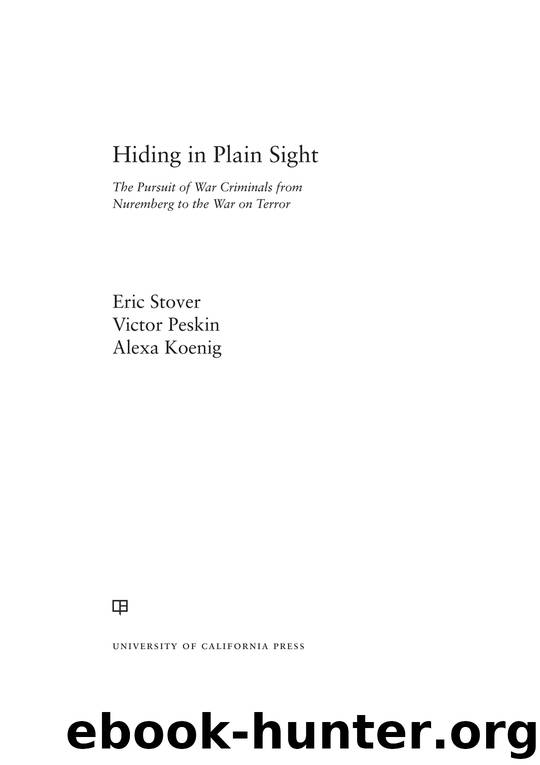Hiding in Plain Sight by Eric Stover

Author:Eric Stover
Language: eng
Format: epub
ISBN: 9780520278059
Publisher: University of California Press
BROTHERS IN ARMS, PARTNERS IN CRIME: SIERRA LEONE
One day in July 1999, half a world away from the beer stall where Duch had confessed his crimes to Nic Dunlop and Nate Thayer, Sierra Leone’s president, Ahmed Tejan Kabbah, and the leader of the Revolutionary United Front (RUF), Foday Sankoh, sat down at a table in Lomé, Togo, to sign a U.S.-brokered peace agreement to end eight years of civil war. The conflict had begun in 1991 when the RUF, a band of Sierra Leonean rebels led by Sankoh and supported by Charles Taylor’s National Patriot Front of Liberia, crossed into Sierra Leone to overthrow the government of Joseph Momoh. The fighting that ensued left 75,000 people dead and more than three million displaced.70
Standing behind the two men, eagerly watching the signing process, was Charles Taylor, president of Liberia. It was a chilling tableau of characters, especially with Foday Sankoh and Charles Taylor, the two men most responsible for some of the worst atrocities committed in Africa since the 1994 Rwandan genocide—killings, mutilations, amputations, sexual slavery, rape, and forced recruitment of child soldiers—at the table playing peacemakers.
Although the Lomé Peace Accord mandated the establishment of a truth and reconciliation commission, it also contained a provision granting “absolute and free pardon and reprieve to all combatants and collaborators . . . up to the time of the signing of the present Agreement”71—in effect, a blanket amnesty for anyone who had committed war crimes during the civil war. At the last minute, however, the UN envoy to the peace talks, Francis Okello, had appended a handwritten reservation to the agreement stating that the United Nations would not recognize any amnesties for “international crimes of genocide, crimes against humanity, war crimes, and other serious violations of international law” enacted by Sierra Leone and Liberia.72 While Okello’s note had no binding legal authority, leaving Sankoh and Taylor free to go about their dirty business without fear of legal censure or judicial restraint, it would serve as a palimpsest, a sort of shadow text that would come to have meaning some years later.
As the ink dried on the parchment, the United States and Great Britain issued statements congratulating the signatories and expressing their “support for the agreement, which will bring to an end the tragic war of Sierra Leone.”73 The Security Council, for its part, welcomed the accord and praised the Sierra Leone government for its “courageous efforts to achieve peace, including legislative and other measures already taken towards implementation of the Peace Agreement”—a reference to the blanket amnesty, seats in government, and other concessions to the rebels provided in the agreement.74 At a news conference in Freetown the following October, U.S. Secretary of State Madeleine Albright defended the amnesty as “the price of a peace so desperately needed after a struggle for power in which severing limbs was a common rebel tactic.”75
Both the accord and the laudations were yet another example of the triumph of hope over experience. The Lomé Peace Accord would bring neither peace to Sierra Leone nor security to her people.
Download
This site does not store any files on its server. We only index and link to content provided by other sites. Please contact the content providers to delete copyright contents if any and email us, we'll remove relevant links or contents immediately.
| Anthropology | Archaeology |
| Philosophy | Politics & Government |
| Social Sciences | Sociology |
| Women's Studies |
The Leavers by Lisa Ko(6502)
Born to Run: by Christopher McDougall(6295)
iGen by Jean M. Twenge(4712)
Sapiens by Yuval Noah Harari(4571)
The Kite Runner by Khaled Hosseini(4496)
Spare by Prince Harry The Duke of Sussex(4238)
Bullshit Jobs by David Graeber(3198)
Livewired by David Eagleman(3148)
Goodbye Paradise(2991)
Never by Ken Follett(2925)
A Dictionary of Sociology by Unknown(2525)
Harry Potter 4 - Harry Potter and The Goblet of Fire by J.K.Rowling(2425)
The Club by A.L. Brooks(2390)
People of the Earth: An Introduction to World Prehistory by Dr. Brian Fagan & Nadia Durrani(2356)
Machine Learning at Scale with H2O by Gregory Keys | David Whiting(2337)
The Social Psychology of Inequality by Unknown(2326)
Harry Potter and the Order of the Phoenix (5) by J.K. Rowling(2246)
Harry Potter and the Deathly Hallows (7) by J.K. Rowling(2242)
0041152001443424520 .pdf by Unknown(2235)
